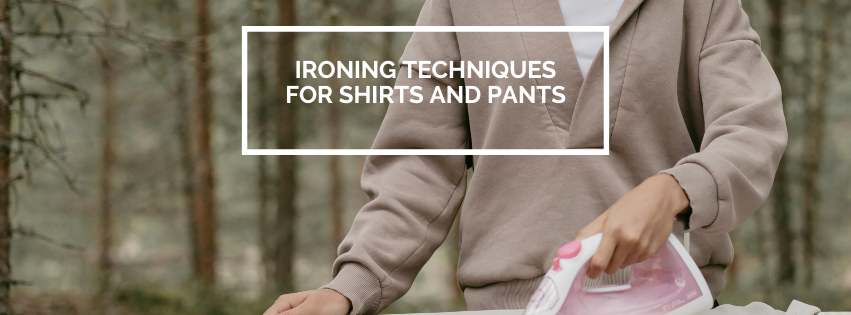Ironing clothes, though often seen as a tedious task, is an essential skill that can significantly enhance your appearance and confidence. Whether preparing for a professional meeting or a casual outing, knowing how to iron shirts and pants properly ensures a crisp, polished look. This comprehensive guide explores the art of ironing, focusing on techniques tailored for both shirts and pants, along with tips to streamline the process and achieve impeccable results.
Understanding Fabric Care
Before delving into specific ironing techniques, it’s crucial to understand the fabrics you’re working with. Different fabrics require varying heat settings and ironing methods to avoid damage and achieve the desired finish. Here are some common fabric types and their recommended ironing practices:
- Cotton: This durable fabric is typically ironed at a high temperature. Steam is often used to remove stubborn wrinkles.
- Linen: Linen should be ironed while slightly damp using a high heat setting. It’s best to iron the fabric on the reverse side to avoid shine.
- Silk: Delicate silk requires low to medium heat and should be ironed on the reverse side or with a pressing cloth to prevent damage.
- Synthetics: Fabrics like polyester or nylon should be ironed at a low temperature to avoid melting or scorching.
Understanding these basics sets the foundation for effective ironing without compromising the quality of your clothes.
Essential Tools for Ironing
Having the right tools can make a significant difference in the quality and efficiency of your ironing routine:
- Iron: Choose a steam iron with adjustable temperature settings suitable for different fabrics.
- Ironing Board: Use a sturdy, well-padded ironing board that provides a smooth surface for ironing.
- Spray Bottle: Fill with water to lightly dampen clothes for easier wrinkle removal.
- Pressing Cloth: Useful for protecting delicate fabrics from direct heat and preventing shine.
Ironing Techniques for Shirts
- Prepare the Shirt:
- Start with a clean, slightly damp shirt. Button all buttons, including cuffs and collar.
- Set Up the Iron:
- Adjust the iron to the appropriate temperature for the fabric (high for cotton, medium for blends, low for delicate fabrics).
- Collar and Cuffs:
- Begin with the collar, ironing it flat and then folding it down. Next, move to the cuffs, ironing both sides and edges.
- Sleeves:
- Lay one sleeve flat on the ironing board. Start from the cuff and work your way up to the shoulder, ironing both sides. Repeat for the other sleeve.
- Yoke and Back:
- Lay the shirt with the back facing up. Iron the yoke (shoulder area) and then move to the back, working from top to bottom.
- Front Panels:
- Finish by ironing the front panels, starting from the placket (buttoned area) and working towards the sides.
- Final Touches:
- Hang the shirt immediately after ironing to prevent wrinkles from forming. Button the top button to maintain collar shape.
Ironing Techniques for Pants
- Prepare the Pants:
- Begin with clean, slightly damp pants. Turn them inside out if they have a lining.
- Set Up the Iron:
- Adjust the iron to the appropriate temperature (medium for most fabrics, high for cotton or linen).
- Waistband and Pockets:
- Start with the waistband, ironing it flat. Then, iron the pockets, ensuring to avoid creasing.
- Legs:
- Iron one leg at a time. Start with the inseam (inside of the leg) and then move to the outer seam. Straighten out any pleats as you go.
- Creases (Optional):
- For dress pants or trousers with creases, use the edge of the ironing board to create a sharp crease down the front of each leg.
- Final Touches:
- Hang the pants immediately after ironing to maintain their shape and prevent wrinkles. Zip or button the pants to preserve the crease and fit.
Tips for Efficient Ironing
- Work in Batches: Group similar fabrics together to streamline the ironing process and reduce temperature adjustments.
- Use Steam Wisely: Steam can help loosen wrinkles, but avoid excessive steam on delicate fabrics to prevent damage.
- Iron in Sections: Divide large garments like shirts or wide-leg pants into manageable sections to ensure thorough ironing.
Conclusion
Mastering ironing techniques for shirts and pants is a valuable skill that enhances the appearance and longevity of your clothing. By understanding fabric care, utilizing the right tools, and following systematic ironing methods, you can achieve professional-looking results at home. Incorporate these techniques into your routine to maintain a polished wardrobe and present yourself confidently in any setting. With practice and attention to detail, you’ll transform ironing from a chore into a satisfying aspect of garment care that contributes to your personal style and comfort.

